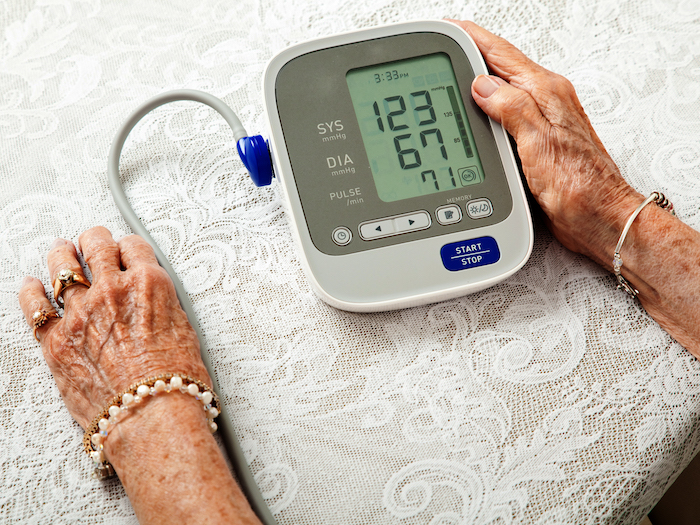How Often Should I Check My Blood Pressure?
The answer depends on your health history. Here's how to figure out your ideal frequency-and get an accurate reading at home.
 High blood pressure, often called “the silent killer,” lives up to its nickname. It puts you at risk for heart attack and stroke, yet rarely causes noticeable symptoms.
High blood pressure, often called “the silent killer,” lives up to its nickname. It puts you at risk for heart attack and stroke, yet rarely causes noticeable symptoms.
The only surefire way to know if your blood pressure is too high is to measure it. Fortunately, that's easy to do. But before you get your reading, you need to know what those numbers mean.
What Exactly Is Blood Pressure?
Blood pressure is pretty much what it sounds like: a measure of the pressure of your blood in your circulatory system.
It consists of two numbers. The top number (systolic) indicates how much pressure your blood is exerting against your artery walls when your heart beats, according to the American Heart Association (AHA). The bottom number (diastolic) measures the pressure against your artery walls while your heart is resting between beats.
Taken together, these numbers give your doctor a sense of how hard your heart is working and the overall health of your arteries.
What Is Normal Blood Pressure?
The AHA provides the following guidelines.
Normal
• Systolic below 120 mmHg AND
• Diastolic below 80 mmHg
Elevated
• Systolic between 120 and 129 mmHg AND
• Diastolic below 80 mmHg
High (Hypertension)
• Systolic above 130 mmHg OR
• Diastolic above 80 mmHg
The higher your blood pressure, the more dangerous it is. “High blood pressure takes its toll on every organ of the body over time,” says Jennifer H. Haythe, M.D., codirector of the Women’s Center for Cardiovascular Health at Columbia University Medical Center and a cardiologist at New York-Presbyterian Hospital.
The good news is that you can do something about it, which usually means making lifestyle changes to lower high blood pressure and sometimes also taking medication.
“By keeping blood pressure in the normal range over time, damage to the heart, brain, kidneys, eyes, and nervous system can be stopped altogether,” Dr. Haythe says.
How and When to Check Your Blood Pressure
If your blood pressure is normal (less than 120/80), the AHA says you should get it checked whenever you see your doctor or at least once every two years. Check with your health plan about benefits, or learn more about Medicare coverage here.
If your blood pressure is elevated or high, your doctor may want to check it more often or may ask you to regularly check it at home, possibly multiple times per day. This is easy to do: You can buy a blood pressure monitor at most drugstores. Many of the devices on the market today are digital and self-inflating.
Subscribe to our newsletter
It's quick and easy. You could be one of the 13 million people who are eligible.
Already a member? Click to discover our 15,000+ participating locations.
Follow Us
To get an accurate reading, follow your particular device's instructions-or better yet, ask your doctor or pharmacist to walk you through it once. For many monitors, the American Academy of Family Physicians recommends resting for three to five minutes and sitting with your legs uncrossed. Place your left arm on a table or desk so that your arm is level with your heart. Wrap the cuff around the upper part of your arm, sit still, and don't talk during the test.
What Else You Can Do—and Warning Signs to Know
If your readings remain high after a few months, your doctor will likely recommend dietary and exercise changes, Dr. Haythe says. If that doesn't work, you'll probably be put on medication and asked to continue to monitor your blood pressure regularly.
"I advise people diagnosed with hypertension to check their blood pressure twice per day until they have it under control," she says. "After that, it's fine to check it one to two times per week."
If your blood pressure is abnormally high or low when you’re checking it at home, don’t panic. It could just be your machine, says Susan Besser, M.D., a primary care physician at Mercy Medical Center in Baltimore. When in doubt (fresh batteries didn’t help?), call your doctor to make an appointment.
Go to the ER right away if a higher reading is accompanied by headache, dizziness, shortness of breath, or chest pain, or if your monitor was working fine but is now reading higher than 180/120.
Check Your SilverSneakers Eligibility Instantly
SilverSneakers members can go to thousands of gyms and fitness locations across the nation, plus take exercise classes designed for seniors and led by supportive instructors. If you have a Medicare Plan, it may include SilverSneakers—at no additional cost. Check your eligibility instantly here.
Already a member? Get your SilverSneakers member ID and exclusive fitness content by logging in to or creating your online account here.





